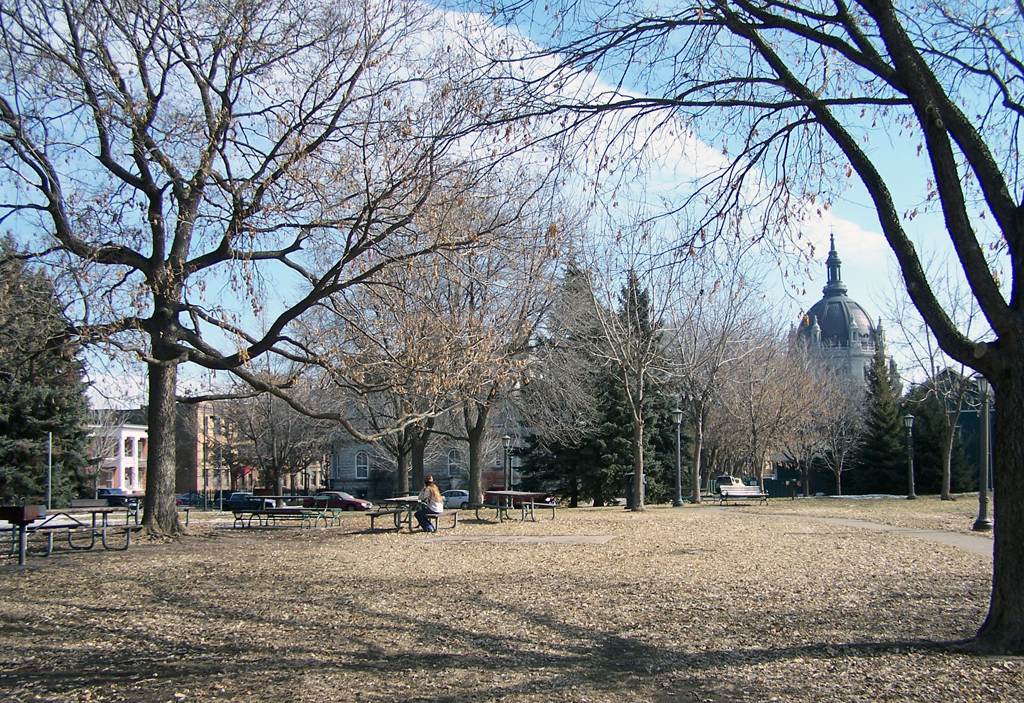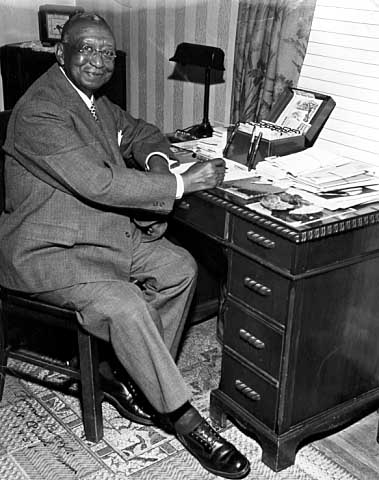
If the two men had been alive, there is little question who would have won the competition. Despite their deaths decades earlier, it was still surprising that a Black union organizer beat out a wealthy entrepreneur who had amassed a fortune, including owning a railroad with James J. Hill.
Both Frank Boyd and Norman Kittson were in transportation and both men helped mold Saint Paul, but any resemblance stops there. They were, by proxy, competitors in a park-naming competition in the Summit-University neighborhood in the 1970s. The park, on Selby between Farrington and Virginia, is pretty and lively with cool shade trees, tended grass, flower-lined walks and plots, picnic tables, grills, and vividly colored playground equipment. It is usually busy. On a summer day, a couple of Black men play chess, another fires up a barbeque grill and pushes picnic tables together, getting ready for a large gathering. Children play boisterously on slides, swings, and gym bars. People stroll meditatively along the paths; couples hold hands; and many use the park as a shortcut from Dayton or Marshall Avenues to the bus that runs on Selby—or to Nina’s Coffee Shop on the corner of Selby and Western that local resident and writer Garrison Keillor made famous in his book Homegrown Democrat.
In 1973 the Ramsey Hill Association unanimously decided to name the park for Norman Kittson. The association had been formed a few years earlier in the midst of urban renewal, partly to rescue as many of the historic and beautiful old houses as possible and to help people restore them to their former glory in very practical ways. Kittson, one of Minnesota’s most important pioneers, was an early fur trader in the American Fur Company. His Red River Transportation Company, formed to transport furs, included a line of steamboats on the Red River and the two-wheeled ox-drawn Red River Carts, famous for their picturesqueness (at least from a distance) and loud squealing from their ungreased axles. Early residents of Summit-University could hear them from miles away as the oxcarts crossed Marshall and Saint Anthony Avenue before heading south and east to downtown Saint Paul.
Kittson moved from the fur trade settlement of Pembina (now in North Dakota) to Saint Paul in 1855, where he was elected mayor. Already wealthy, he joined James J. Hill in acquiring the Saint Paul and Pacific Railroad, which eventually became the Great Northern Railway. He bought land from Jeremiah Selby’s widow up on the bluff above the city called Saint Anthony Hill, where in 1884 he built a beautiful lavish Second Empire mansion. After his death in 1888, the Kittson family broke up, and the mansion was neglected and eventually it became a rooming house. Kittson’s neighbor, James J. Hill, was offended by the flophouse nearly next door, and in 1904 the site was turned over to the Archdiocese of Saint Paul, which tore down the old-fashioned mansion and built the Saint Paul Cathedral, a massive, commanding presence that looms over the city.
Porters were expected to work 400 hours a month or travel 11,000 miles with almost no provisions for their rest. They were summarily fired for the slightest transgressions—such as falling asleep after several contiguous shifts.
The Ramsey Hill Association wanted to name the park for the old fur trader, saying (inaccurately) that Kittson was “the oldest settler in this region,” and that “Saint Paul will always remember Norman Kittson as one of its most substantial and enterprising citizens.” The Saint Paul City Council agreed.
Not so fast, responded the Selby-Dale Freedom Brigade, whose opinion of Kittson was radically different from that of the Ramsey Hill Association. The brigade was part of a group of people, mostly young, who had moved into Summit-U in the late 1960s and 1970s when they could find cheap rooms and apartments in these chopped-up big old houses. Most were students and dropouts from the nearby colleges and universities, and many of them had embraced the counterculture in these turbulent years of the Vietnam War protests and the violence and upheaval of the civil rights movement. A range of ideologies was represented, from liberals and left-wingers to a handful of communists and Maoists, but all of them tried to ally themselves with the African Americans and with the poor in Summit–U as the neighborhood confronted urban renewal (which the Blacks called “Negro removal”). A major issue was that the people in the community had very little voice about what was happening and that housing units were being torn down faster than new ones could be built.

The Selby-Dale Freedom Brigade, which emerged out of this melange of ideologies, objected to using Kittson’s name for the park on the grounds that this nineteenth-and early twentieth-century entrepreneur was not a fit man to memorialize. Not only had he had at least two and as many as four Native American “wives” before marrying European Mary Kittson, he sold liquor to the Indians and bought their fur pelts for a pittance and sold them for exorbitant amounts. One brigade member said Kittson “personifies the destructive, imperialistic aspect of American history,” and he urged that parks and public buildings be named “for people who have contributed to the struggles faced by those exploited.”
Frank Boyd was their candidate. He had moved in 1912 to Saint Paul, which had become a major railroad center, and got a job as a sleeping car porter for the Pullman Company in 1919. It was considered a good job, more desirable than fieldwork, as historian Arthur McWatt, a lifelong resident of Summit-U, and a retired teacher, writes. But the jobs came “at a high price.” Porters were expected to work 400 hours a month or travel 11,000 miles with almost no provisions for their rest. They were summarily fired for the slightest transgressions—such as falling asleep after several contiguous shifts. “The Pullman Palace Car Company became the largest private employer of African Americans by the 1920s,” writes McWatt. Many of the men employed as porters were well educated—engineers, lawyers, science and business majors. One resident estimated that 50 percent of the Black men in Summit-U were porters.
Art By: